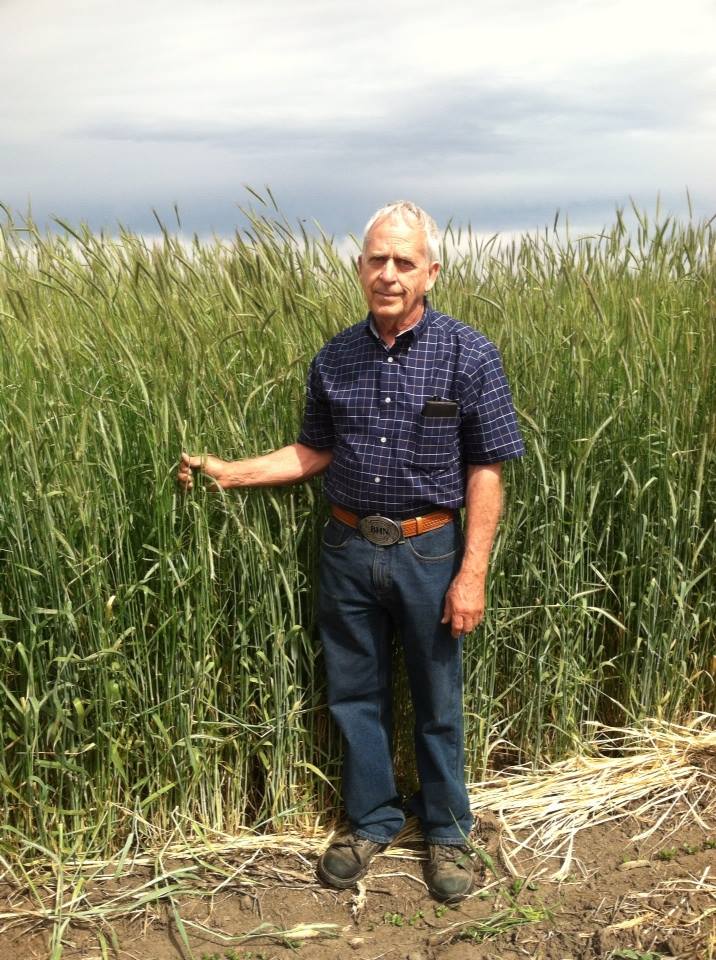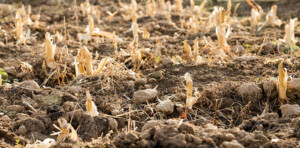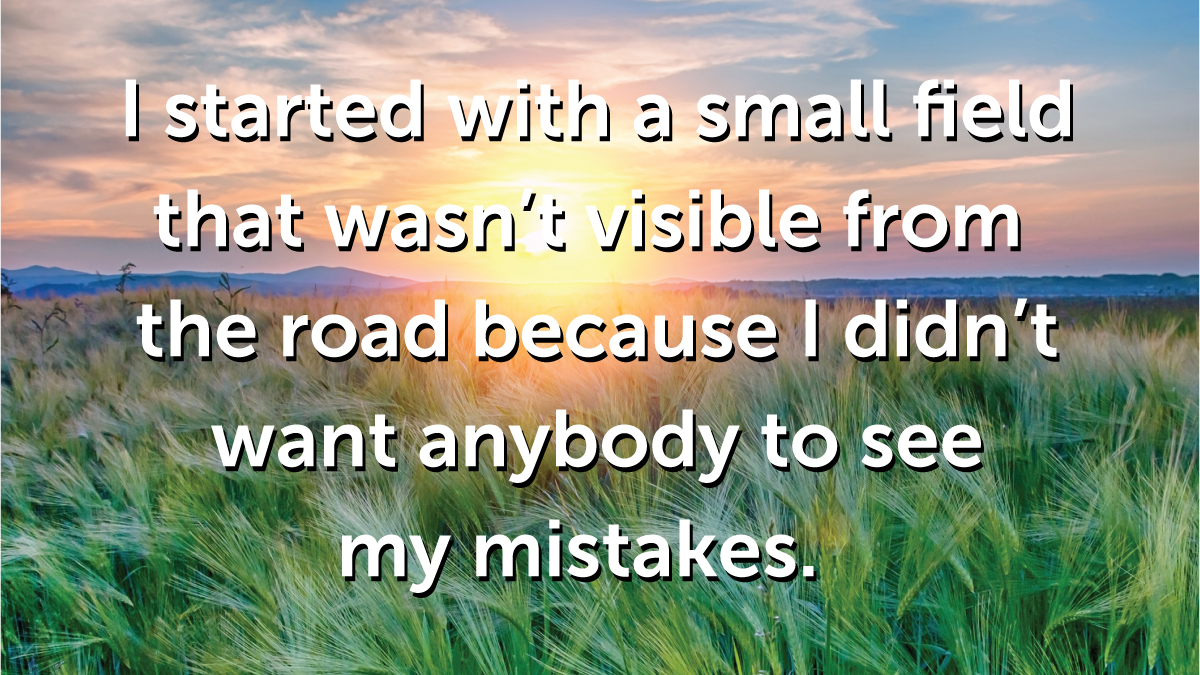
Dan Hilger in his 2nd year growing rye, May 2015
An Interview with Nebraska Farmer Dan Hilger
By Jael Batty
Nebraska farmer Dan Hilger recently incorporated rye into his corn and soybean crop rotation. Cover crops are a natural addition to Dan’s farming methods, which include minimum tillage and biostimulant inputs (Huma Gro® products). These practices increase soil health, reduce pest and weed pressure, and diversify his income.
In the following interview, we discuss the popcorn farmer’s rye growing practices.
What influenced you to start growing rye cover crops?
Herbicide resistance is getting worse every year. One of the main reasons I planted rye is because it reduces weed pressure. We began growing rye five years ago. I started with a small field that wasn’t visible from the road because I didn’t want anybody to see my mistakes. Now we plant 100% corn and bean ground in the fall that goes into rye.
How to Seed Rye
Typically, we seed it with a no-till drill as soon as possible after harvest. This year we’re going to fly seed on before the soybean harvest, while the soybean leaves are still yellow. Then the leaves will fall onto the rye seed and form a mulch. This gives us a month’s head start to get a crop growing. By the time we’re combining the beans, the rye is sprouting. By May first, we’ll have a good stand of rye out there to work with.
 Tell us about your cover crop process.
Tell us about your cover crop process.
Not every year is the same. There’s no absolute process. It’s just like any other crop; you learn to work with what you got.
Some years we seed early in the fall; some years it’s the middle of November. That makes quite a difference in how much growth we get in the spring.
Whether or not it warms up early in the spring also affects how much growth you get in the spring.
Inter-seeding Rye
We’ve tried inter-seeding when the corn is knee-high to help pull down weeds. This year was just too wet to plant cover crops when the corn was small. Hopefully, next year it will work out a little better.
Cover Crop Diversity
Now, we’re getting into a three-year rotation. The ground that we harvested for rye this year, we then seeded with a multi-species cover crop to get us through the winter. We planted radishes and turnips and legumes and 50-60% rye—because everything except the rye is going to winterkill. So, we’ll still have something growing there in the spring.
We’ll kill that in the spring and plant corn. The next year, we’ll plant soybeans. After the soybean harvest, we’ll plant rye that will stay rye for seed. That’s going to be a good rotation to have.
Other cover croppers say the year after the planting a multi-species cover crop, you raise fantastic corn. So, we’re looking forward to that.
With the multi-species crop rotation, you alternate broad-leaf plants (which have a rounded leaf) with your grass types, like corn or rye (which have long, straight leaves). The more you can go from broadleaf to grass to broadleaf to grass, the better it is for the soil. You mix things up in a beneficial way for the soil, in terms of the nutrients they add to and take from the soil.
If for example, you’re running continuous corn, there are certain nutrients that are used up in the soil. You also have a buildup of corn rootworms and insects that attack the corn. If you do the rotation, those pests have a harder time surviving. That’s something that helps the whole system out. It breaks up the cycle of pests.
What struggles have you had learning to grow cover crops?
One of the biggest challenges people run into is how to terminate rye. Corn or beans get off to a slow start if you don’t kill it. And that will affect your yields.
How to Kill Rye
As far as killing it, some people use an herbicide. If you let it grow tall enough, you can come in with a crimper that crimps the rye at 6 inches or so and that kills it. The rye has to get 2-3 feet tall before the machines will work. If you come in with the crimper when the rye is 8-10 inches tall, it won’t kill it.
When to Kill Rye
Originally, we thought we needed to kill it a week or so before planting, but now we’re finding that we can kill it immediately before planting. In some cases, we can kill it after planting, before the new crop comes up. You get a little bit more cover that helps hold back the weed pressure.
Killing Rye in Hot, Dry Weather
It shades the ground. So, if you do have hot, dry weather, the ground doesn’t dry out near as fast. On the other hand, if you get a really dry year, you can come in early and kill that rye, so it doesn’t suck up too much of the moisture.
Killing Rye in Wet Weather
If it’s really wet, you might want to let it grow. Let it soak up some of that moisture. Dry out the ground a little bit so you can get in there. There will always be some management decisions to make on the spot.
The Cover Crop Learning Curve
Unfortunately, there are no absolute steps. It varies with different soils, different weather conditions, how soon you want to plant your corn. Farmers have to learn to terminate at a time that works best for their system.
Every year, we learn a little more about how to raise rye. Up until a few years ago, we never raised it for seed. So, now we’re learning how to fertilize it.
Have cover crops affected the amounts of inputs you need?
We have a major surplus of carbon in our air today because of all the emissions. Cover crops pull carbon out of the air and turn it into plant matter. When that plant matter breaks down, it turns into several different nutrients in the soil.
I’m starting to see soil tests where I need less and less nitrogen and phosphate. The longer we do this, the more I’ll be able to back off of my fertilizer inputs. That takes time.
What other benefits have you experienced with rye?
Yield Increases
Cover crops have affected yields. Because our soils are getting healthier, and because we learn more about it every year, our rye harvest increases each year. Corn yields have increased about 20 bushels/acre and beans have increased 30 bushels/acre.
Moisture Control
The soil has more water-holding capacity. So, when we get these really hot days, the corn and the beans have less stress on them. Because of that, I’m saving money on irrigation. I irrigate less than the farmers who don’t plant cover crops.
Cost Savings
Many farmers are concerned about the cost of cover crops, but I save enough on irrigation to pay for the seed, if not more. Using rye cover crops for weed control saves me the cost of herbicides which also helps to pay for my rye seed.
Selling Rye Seed
In fact, with the low commodity prices—and because there’s demand for rye cover seed and it’s not traded on the Board of Trades—the rye that we’re harvesting for seed will probably be my most profitable crop this year.
What is your advice to farmers who want to begin growing cover crops?
Start Small and Learn from Other Farmers
Start out with part of your farm and increase year after year. If you make any mistakes, they’ll be small mistakes. Learn from other farmers’ mistakes and tap into other farmers’ brains, rather than learning at the old school of hard knocks. We have educational programs for people interested in cover crops. There are conferences around the state, field tours where you can see how cover crops are raised.
Be Patient
It takes a while for the cover crop to have a major effect. A lot of farmers want to see a cash return the first year. You have to be patient. Don’t look for miracles the first year. It takes three to five years to get the cycle going to where it’s doing a lot of good.
For more information about Dan Hilger’s innovative farming methods, read “Popcorn Farmer Combats Current Farming Challenges.”
Dan Hilger has been farming for 55 years in Nebraska where he grows corn, soybeans, and rye. Hilger produces Hilger Agri-Natural Popcorn, a gourmet, hull-less, non-GMO popcorn that is free of herbicide and pesticide. Hilger Agri-Natural Popcorn is available in Nebraska markets and online a www.hilgeragrinatural.com.
Related Posts

Earth Day: “It’s Getting Better All the Time”
Celebrating Earth Day every April 22 is a great time to pause and reflect: How are we, today, treating the environment and the plants, animals, and people who live in it? What have we accomplished in the past year that makes our planet a better, more sustainable place to live and raise our families? What are our goals for future improvement?

Fall Is Fertil Humus® Time
Our Fertil Humus® product, when applied in the fall, can help degrade any crop residue or crop field trash that’s left behind and convert it to humus over the winter.

Subscribe to “The Huma Gro Farmer” Podcast
Subscribe to The Huma Gro® Farmer podcast, in which we discuss crop nutrition and crop protection with experts in the field. Your host, Larry Cooper, interviews agronomists, certified crop advisors, and Huma Gro® distributors and customers about proven Huma Gro® programs and strategies for growing premium, high yield crops. Subscribe through your favorite smart-phone podcast

 Tell us about your cover crop process.
Tell us about your cover crop process.
